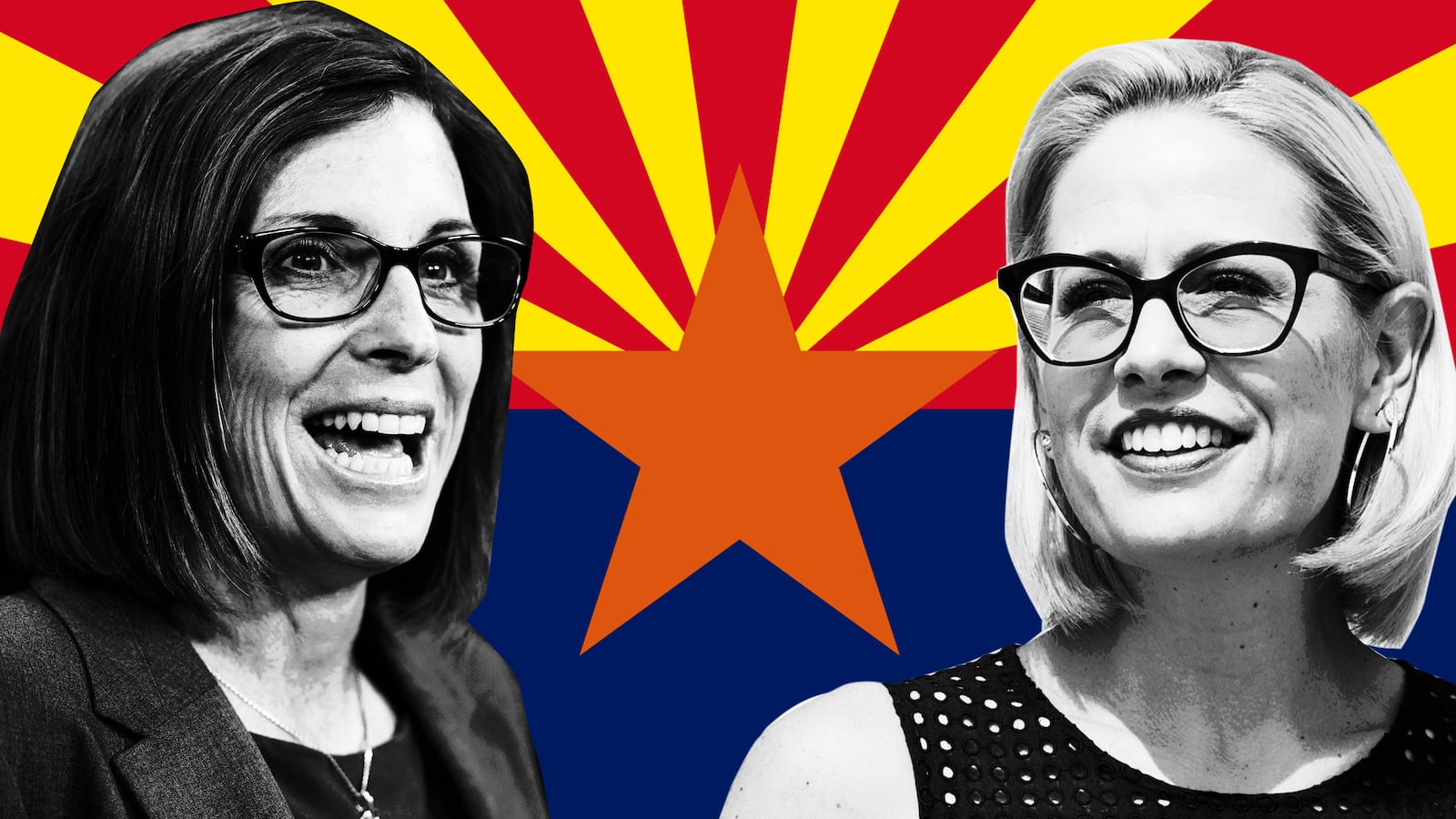PHOENIX, Arizona—As one of the 2018 election cycle’s tightest races grows fiercer by the day, the real race in Arizona may be each candidate’s sprint to distance herself from unhelpful aspects of her record.
In her bid to replace outgoing Sen. Jeff Flake, Republican nominee Rep. Martha McSally is running away from her centrist record in Congress by embracing a new identity as a right-winger working hand in glove with President Donald Trump. Meanwhile, her Democratic opponent, Rep. Kyrsten Sinema, is hoping that her own strong congressional history as an independent centrist will overpower McSally’s attempts to paint her as too extreme for Arizona voters.
“The contrast could not be more clear,” McSally said at a campaign rally in Mesa on Friday, lambasting Sinema’s decades-old past as a left-wing activist as President Trump looked on. “I said I would vote for Kavanaugh. Sinema said she would vote ‘no.’ I was shooting at the Taliban, and Sinema says that it’s OK for an American to join the Taliban. I was wearing a flight suit, and she was wearing a pink tutu!”
“The contrast between me and my opponent Martha couldn’t be more clear,” Sinema said at a volunteer event in Phoenix on Sunday. “The differences between us are real.”
For both candidates, this shape-shifting strategy has invited accusations of cynical inauthenticity. “Both U.S. Senate candidates have been wearing false fronts since the primary, and everyone knows it,” chided the Arizona Republic’s editorial board in its endorsement of Sinema’s candidacy. “That’s the pity of this race. All either candidate had to do was be herself—or, at least, the self both displayed as U.S. House members—and the race would be just as competitive, particularly among independents and moderates.”
Instead, the race to become Arizona’s first female senator has become one of the most fiercely negative campaigns in recent memory. In a state where Senate races haven’t been competitive between the two major parties in decades, McSally’s campaign has run advertisements depicting Sinema as a tutu-sporting radical leftist who mocks the state to non-Arizonans, and even accused the three-term congresswoman of dabbling in light treason during a debate.
The conservative political action committee DefendArizona, a pro-McSally group backed by wealthy Arizona Republicans, went literally nuclear in one mailer sent to voters across the state earlier this month. The mailer, which told voters that “KYRSTEN SINEMA WON’T KEEP ARIZONA SAFE,” featured a hologram that, when tilted, showed a mushroom cloud over downtown Phoenix.
Sinema’s campaign has largely avoided direct personal attacks on McSally, instead producing ads that highlight kitchen-table issues like health care and education, as well as the candidate’s compelling personal story. But with millions of dollars in outside money pouring into the state from pro-Sinema PACs, the volume of the negative ads risks turning off Arizona voters not used to such bitter campaigning.
“In Arizona, where one party has dominated statewide races since the 1990s, we don’t have a lot of experience with these highly competitive, negative campaigns,” professor Kim Fridkin, an expert on women in politics at Arizona State University’s School of Politics and Global Studies, told The Daily Beast. “There’s been a ton of outside money in this race, and when most people watch the ads... a lot of the negative ads attacking McSally are not actually Sinema’s campaign. But people don’t look at that—they just see the attacks going back and forth.”
Fridkin, who specializes in negative campaigns, women in politics and races for the U.S. Senate, believes that the intense negativity in the closing days of the campaign may be a smart strategy for a Republican like McSally, whose newfound lockstep alignment with Trump’s agenda makes her a difficult sell to more independent-minded voters.
“When there’s this kind of irrelevant and uncivil discourse, it tends to alienate people who are not as attached to the party, and also people who are independents and women,” said Fridkin, noting that these three groups are expected to show up to the polls in a high-turnout election. “It could be that that’s part of the plan: try to alienate people who would support [Sinema] and then endorse Trump as strongly as possible to get his base out to the polls.”
That thesis resonated among patrons at the McFate Brewing Company in South Scottsdale, whose clientele of young, educated professionals—many of them out-of-state transplants—are precisely the kind of voters likely to show up to the polls in a high-turnout midterm, and exactly the kind of voters Sinema is relying on to deliver the seat.
Many of them expressed disgust with the tenor of the campaign, to the point that voting for either candidate would feel like capitulating to a race-to-the-bottom campaign.
“You turn on the ads, and they both seem like they’re just terrible people,” said Joe Nilsen, a business manager native to San Diego who said he felt like voting for either candidate meant voting for “a jerk.”
“It’s impossible to decide—you don’t know which [advertisements] to trust, so you just don’t end up wanting to vote at all,” said friend Michael Ralph, an engineer in his mid-twenties. “And the ads are constantly running, so you kinda can’t avoid them.”
That disgust is good news for the McSally campaign, Fridkin said.
“In a normal midterm election in Arizona, Republicans are at an advantage because their voters are more likely to turn out than Democratic voters, and there are more of them,” Fridkin said. But after midterm primary turnout shattered records in the state, McSally’s camp has appeared to determine that bringing Trump’s base to the polls is an easier venture than winning over independents in the general election—even with McSally’s moderate legislative track record.
“She’s calculating that she’s going to be able to motivate Trump’s base here in Arizona by embracing Trump,” Fridkin said. “There’s no room between Trump and McSally right now.”
McSally has certainly tied her fate to that of the president’s. At Friday’s rally, McSally told Trump’s supporters that “America is back—and Arizona is back—thanks to the leadership of President Trump,” positively citing his policies on immigration and judicial nominations as examples of a pro-Trump agenda she would support in the Senate.
But as Sinema’s campaign and others have pointed out, McSally is quite a recent convert to Trumpism. McSally, whose Tucson-area congressional district broke for Hillary Clinton by a five-point margin in 2016, was until recently a DACA-supporting centrist, a proponent of a pathway to citizenship for some undocumented immigrants who declined to endorse Trump’s candidacy in 2016.
Part of the difference may be the vastly different primary experiences of the two candidates. Sinema, a near-lock for the Democratic nomination since she announced her candidacy in September 2017, spent the majority of her primary campaign building positive name recognition statewide with glossy videos highlighting an impoverished childhood and her time as a social worker. McSally, meanwhile, spent a bruising Republican primary fending off two right-wing candidates with unimpeachable pro-Trump bona fides. After announcing her candidacy, the former fighter pilot began hugging the president’s position on everything from his proposed border wall to trade.
Even McSally’s support for the nomination of now-Justice Brett Kavanaugh to the Supreme Court, which she cited as one of the president’s greatest achievements at the Mesa rally on Friday, came at the last possible moment. After initially praising Kavanaugh upon his nomination to replace retiring Supreme Court Justice Anthony Kennedy in July, McSally avoided taking a position on Kavanaugh’s confirmation after multiple women came forward with allegations of sexual assault against the nominee.
Only in the waning hours before the final Senate vote did McSally, whose own story of sexual abuse as a teenager closely mirrored the complaints against Kavanaugh, end up endorsing his nomination.
The roughly 4,000 people gathered at the International Air Response Hangar on the outskirts of Mesa didn’t hear that part, however.
“We have Justice Brett Kavanaugh on the bench!” McSally said at the time. “I said I would vote for Kavanaugh. Sinema said she would vote ‘no,’” she continued, to loud boos from an audience with an apparently short memory.
Setting aside McSally’s newfound pro-Trump platform and the allegations of treason against Sinema for a flippant 2003 comment that she was “fine” with Americans joining the Taliban, both candidates share centrist reputations as members of the House of Representatives. Each is an IronMan finisher representing a swing congressional district in a state that is famously accommodating of maverick politicians.
Sinema has sided with Trump’s legislative agenda more than 62 percent of the time, according to FiveThirtyEight, particularly on defense. She voted to make permanent the president’s signature tax cuts, which most Democrats are actively running against, and voted in favor of a bill that included $1.6 billion in appropriations for a wall along the U.S. Southern border. Even her campaign logo is purple.
“I couldn’t be more proud to have support from Democrats, independents, and Republicans in this campaign, because it‘s a hallmark of who we are and what we do” in Arizona, Sinema said on a Friday call with reporters. “This is why I’ve been ranked the most bipartisan member of the House; it’s why I have been ranked the third-most independent member of the House—it’s because this approach works.”
For her part, McSally’s approach to Obamacare is comparatively moderate for a Republican member of the House—she has called for changing the legislation rather than the full-scale repeal demanded by most congressional Republicans—and as ProPublica has noted, she has voted with Sinema more than 50 percent of the time in the 115th Congress.
The difference, Republican supporters of Sinema told The Daily Beast, is that Sinema hasn’t turned her back on her centrism in the hopes of winning Flake’s seat.
“She has a voting record that proves that she’s a moderate—she doesn’t have an ‘R’ or a ‘D’ label,” said Rick Ireland, a veteran and father of two veterans who co-chairs the group Republicans for Sinema. “She supports Arizona.”
“I am a lifelong Republican, and a Republican elected official as well,” said Susan Gerard, a former state lawmaker and current chair of Maricopa County’s health care board. “You really need to compromise and take into account multiple viewpoints if you’re going to put together coalitions to make good public policy” in Arizona, she continued.
McSally’s hard turn to the right, the Sinema campaign told The Daily Beast, is the only negative they need to focus on in the final days of the campaign.
“She was a centrist, and she flipped so totally, and so quickly—on pre-existing conditions, on DACA—that I think people don’t trust her,” said communications director James Owens. “Her own base doesn’t trust her.”
Even those record-based rebuttals, Fridkin warned, risk turning off voters who want to vote for a candidate more than against another.
“[Sinema] has to come back and be more positive and talk more about how she can work across party lines, and how she has a record as a moderate for Arizona,” Fridkin said. “She has to remind people that she has, in the House, this moderate voting record and this history of working with people across party lines.”
At the Phoenix headquarters of the United Food and Commercial Workers union, the largest labor union in the state, Sinema appeared to be leaning into that strategy on Sunday afternoon.
“We have the support of people all over the state who understand that I’m running for Senate because I share the values of everyday Arizonans,” Sinema said. “If we can turn out the folks who share our values, and are aligned with our concerns to take care of the issues that matter most to everyday Arizonans, we are going to win this race.”







